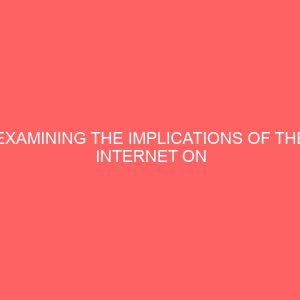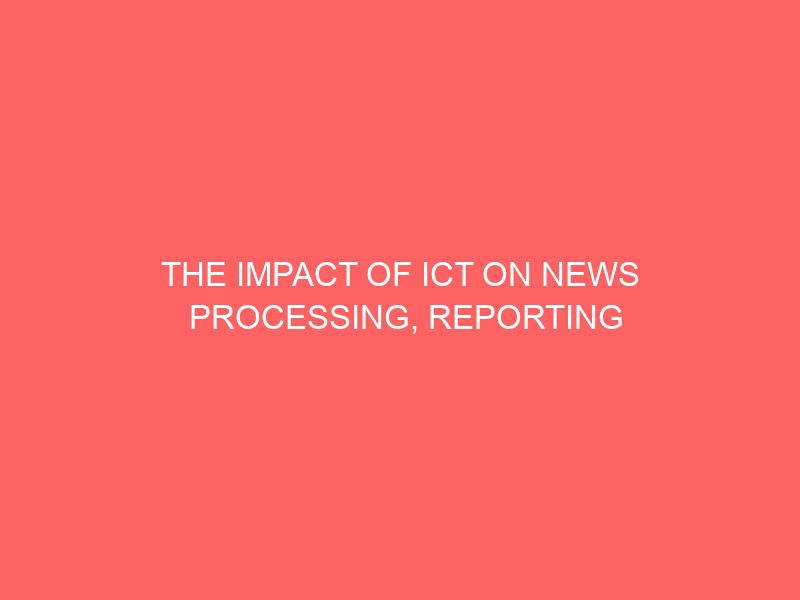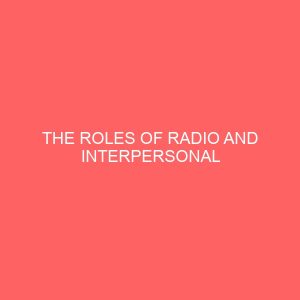Description
ABSTRACT
Information and communication has swept the world with powerful force affecting the society. Supported in its entirety by the communication technology, information spread vastly become faster and cheaper. The media through which information is disseminated also gets varied in types, further revolutionizing the information era. In the past, there is a significant time lag separating the point when an event took place and the time when the news may be publicly available. This study attempts to investigate the impact of information and communication in news process: a study of AIT and NTA. It is presumed that the radical changes brought in the realm of information through Information and Communication Technology ICT revolution has affected immensely the broadcast more than any other industry. In the same way, the level of adoption and absorption of Information and Communication Technology are being carried out in broadcast industry by bringing efficiencies in all the functional wings including production.
editorial and marketing so as to gain competitive advantage. We cannot but say that ICT facilitates the creation, storage, management and dissemination of information by electronic means. This study uncovered some of the numerous benefits and challenges associated with the use of ICT in news processing in broadcast industry. This study employs diffusion of innovation theory and technological determinism theory as the theoretical framework. This study concludes that ICT has created opportunities for widespread electronic delivery of news. Furthermore, the Internet can be viewed as both an opportunity and a threat to the news industry. However, not only are there technology barriers that news organizations need to overcome to deliver news electronically, but there are also problems of employee attitudes toward new technologies and resistance to change, and above all, the implication of this in the society will lead to an overall shrink in the need for human correspondents
CHAPTER ONE
INTRODUCTION
1.1 BACKGROUND TO THE STUDY
Before we explore the impact of ICT on news process lets look at the words of Silverstone 2000 as he pointed out Media are changing, have changed, radically. Our century has seen the telephone, film, radio, television become both objects of mass consumption and essential tools for the conduct of everyday life. We are now confronted by the spectre of a further intensification of mediated culture, through the global growth of the Internet and the promise some might say the threat of an interactive world in which nothing and no one cannot be accessed, instantly. Much of contemporary debate draws on a sense of the speed of these various changes and developments, but mistakes the speed of technological change, or indeed of commodity change, for the speed of social and cultural change. There is a constant tension between the technological, the commercial and the social, a tension that must be addressed if we are to recognize media as indeed a process of mediation. Silverstone 2000
To a large extent, it is believed that Information is the primary input as well as the final output of a broadcast industry. It collects raw information and converts it into categorized, defined and useful pieces of information. Therefore it will not be an exaggeration to say that the radical changes brought in the realm of information through Information and Communication Technology ICT revolution are bound to affect the broadcast industry more than any other industry. The adoption and absorption of Information and Communication Technology are being carried out in broadcast industry by bringing efficiencies in all the functional wings including production, editorial and marketing so as to gain competitive advantage. Gester 2003 points out that ICT facilitates the creation, storage, management and dissemination of information by electronic means.
Operationally ICTs comprise digital devices either notifies the hard wares, or softwares for transferring information. It includes low cost means of communication like radio, GSM/mobile phones and digital television.
In the same vein, Adekomi in Soforowa 2009 see ICT as the integration and utilization of computer technologies for the purpose of disseminating information to a target destination or consumer without the constraint of time and space
Information and Communication technology in broadcast news gathering in on the increase by reporters and editors. Its benefits are being recognized at every point of the entire supply chain of news. Technology development and absorption in broadcast industry has improved the packaging of news. The profuse use of online content and facilities has led to high productivity and efficiency at a reduce cost. Lapham, 1995 The wide range of recording of news with high sophistication, editing database, photo imaging, and mixing software provided cuttingedge facilities to broadcast industry. The use of telefax, websites, online database, and web based information sites, and online readers and newsmakers, made the cumbersome job of information collection and reporting easier than ever before. It would not be wrong to postulate that whole nature of editorial job has changed under the influence of IT.
Information and communication technologies ICT is an umbrella term that covers all technical means for processing and communicating information. The term has gained popularity partially due to the convergence of information technology IT and telecom technology. ICT defines a broad range of technologies, including methods for communication communication protocols, transmission techniques, communications equipment, media communication, as well as techniques for storing and processing information computing, data storage, etc.
Also, Information and communication technologies ICT are often associated with hightech devices, such as computers and software, but ICT also encompasses more conventional technologies such as radio, television and telephone technology.
The term, information and communication technology ICT refers to forms of technology that are used to transmit, store, create, share or exchange information. This broad definition of ICT includes such technologies as: radio, television, video, DVD, telephone both fixed line and mobile phones, satellite systems, computer and network hardware and software; as well as the equipment and services associated with these technologies, such as videoconferencing and electronic mail. Wikepedia.2009.
Rogers in Berniger 2005:2, states that communication technology is the hardware equipment, organizational structures, and social values by which individuals collect, process, and exchange information with other individuals.
In the same way, high technology approaches to news processing have set in motion an evolution in strategies of news gathering in the first half of this decade. Central to these new approaches is the use of personal computer, Williams and Sawyer 2003:3 pointed out that a computer is a programmable, multiuse machine that accept data raw fact and figures, manipulate and process it into information that we can use, such as summaries, totals or reports its purpose is to speed up problem solving and increase productivity.
Communication technologies are the nervous system of contemporary society, transmitting and distributing sensory and control information, and interconnectivity a myriad of interdependent units Rogers cited Berniger 2005:4. One of the hallmarks of industrial revolution was the introduction of new communication technologies as mechanisms of
control that played an important role in almost every area of the production and the distribution of manufactured goods. Rogers cited Berniger 2005:4
Collins 2003: 65, argues that the number of transistors on a chip as crude measure of the computing power, doubles approximately every 18 months since 1967, because of this steady advancement in hardware, it is feasible for computers to solve very complex problems in a relative short time. In addition to this increase in processing, there has been an increase in the amount of storage available and the amount of information that can be transmitted over data communication network. The adoption of personal computers as a news reporting tool is a two prong approach to news processing commonly known as computer assisted reporting. Computerassisted reporting CAR, includes both a onlinebased newsgathering that uses specialized commercial services and Internetbased services, such as the World Wide Web, and b databaseoriented analysis using existing and originally created databases from both the public and private sectors Garrison, 1995.
As personal computers became less expensive in the past decade, the devices began to appear in newsrooms around the nation and their uses in newsgathering began to expand. At the same time, the computing power and speed of desktop computers have also increased, permitting reporters to attempt many of the same tasks for which they would have used larger mainframe or midrange computer systems just a few years earlier.
Between 1994 and 1996, computerassisted reporting has moved toward a second stage in its development. Instead of being limited to special investigative teams or to desks whose reporters work exclusively on such reporting, some newsrooms have begun to move toward total integration in newsrooms. This has been facilitated by the conversion in some newsrooms of dedicated wordprocessing computer systems devoted solely to production to PCbased local area networks capable of production and to enhance broadcast news, but also capable of all other PCtype functions, such as online connections and data processing or analysis Garrison, 1996.
In the past few decades information and communication technology has transformed the world in all spheres of life. Its potential for reducing manual operations and fostering growth in the media has increased rapidly. According to Okoye 2000:195, computer technology has enhanced news processing and news reporting. With the Internet, journalist can now click on relevant sites to source for foreign or even local news for subsequent broadcast news, this will likely lead to an overall shrink in the need for human correspondents.
The importance of computer technology as a tool for news processing cannot be overemphasized. The adoption of computer technology in broadcast industry has revolutionized and enhanced news processing. Access to information is fundamental to empowerment, recognizing the impact of increasing digital convergence on media has created an enabling environment to ensuring peoples access to information through the adoption of this technology.
1.2 STATEMENT OF PROBLEM
It could be argued that the employment of computer technology in the newsroom and in news processing will increase cost, as money would have to be invested into acquiring both hardware and software creating or building websites, include remunerations for personnel that would man and constantly maintain them. However, going by global trends, which foretell an increase in the employment and the deployment of computer technology in news processing, in order to achieve better efficiency, accuracy, and speed up operations of news processing, Gester 2003 points out that ICT facilitates the creation, storage,
Gester 2003 points out that ICT facilitates the creation, storage, management and dissemination of information by electronic means, Abiahenu 2006 pointed that ICT facilitates communication and processing of information, saves time and reduce cost.
However, when information technology is discussed, it puts people out of jobs. The reverse is often the case. This technology takes over mechanical assignment and frees individuals for more intellectual productive work Similarly, if this technology will achieve its overall objective, there is need for faster and more accurate means of solving manual operations of data processing and better storage devices for information and data as provided by the computer system, the complexities of modern technology have produced great mathematical, scientific, and engineering problem and hence, enhanced news processing. The Nigerian broadcast and print media like other facet of life and human endeavour in the country have embraced information and communication technology to some extent.
In this vein, this study tends to investigate the challenges facing media organization with a view of finding out the effect of the use of information and communication technology in news processing. Also, we will identify the constraints to the use of information technology in news processing.
1.3PURPOSE OF THE STUDY
1.To ascertain the impact of information and communication technology ICT in news processing in Nigeria.
2.To investigate the constraints to the use of information and communication technology in news processing in Nigeria.
3.To identify the various ways ICT enhances news processing in Nigeria .
1.4 RESEARCH QUESTIONS
What is the impact of information and communication technology ICT in news processing in Nigeria
What are the constraints to the use of information and communication technology in news processing in Nigeria
In what ways can ICT enhance news processing in Nigeria
1.5 SIGNIFICANCE OF THE STUDY
According to the Wikipedia encyclopedia Information technology IT or Information and communications technology ICT is a broad subject concerned with technology and other aspects of managing and processing information, especially in large organizations. This draws attention to the fact that ICT involves technology that can be used to communicate or rather to convey messages.
ICT has had several effects on news men, with some of them seen as advantages while others as disadvantages, the computer and the
modem, along with many other ICT hardware and software innovations and services, have placed a high point of a very significant stage of development in the history of human communication, often called, the information society, and have transformed the way many men and women work in the media and entertainment industries. It is believed that ICT has brought about significant changes in the job. ICT has led to the generation of more and well researched news. With the coming of mobile phones, you can call your news sources at anytime and get news and moreover wellbalanced and researched news. When it comes to the Internet, news and program backgrounders are always available. Think of any topic you are working, from health, education, lifestyle, to environment you cannot fail to get information to help you enrich your story especially with those hard to get facts coupled with pictures. The Internet has surely transformed the newsroom to greater heights. It is important to note that this comes as a result of globalization and it is also a cause of globalization in one way. As a matter of fact, information and communication technology ICT has bridged the gap of distance and solve the problem of transportation, journalists can now file in their story from any part of the country, where an Internet access is available. Recognizing the fact the Internet offers greater editorial freedom and the ability to publish breaking news. More so, Internet skills help to provide media professionals with the tools they need to develop alternative news outlets.
Ultimately, the adoption of these technologies have tremendously revolutionalized the media house towards profitability. This technology has enhanced cost of production, improved quality of product; however, the effect of this technology would result to reduction in staff as most of the operations would be done by information and communication personnel.
Carisson 2005:204, argues that, The development of innovative information technologies and the ongoing processes of deregulation and
concentration of ownership, have spurred the pace of globalization especially communications satellites and digitalization not least the Internet have had an enormous impact. ICT has helped to bring closer communicators and receivers to the extent that feedback is swift. This in turn makes communication process participatory, useful and development focused as it centers on the audience. Servaes and Malikhao 2005;91, argue that, Participatory, which necessitates reasoning and moreover trust will help reduce the social distance between communicators and receivers, between teachers and learners, between leaders and followers as well as facilitate a more equitable exchange of ideals this draws attention to the fact that ICT has made exchange of ideas between communicators and receivers easy hence making the communication process people centered. In the same way, considering the fact that the use of information and communication technology has reduced stress and cost implication in the tedious operations in the media industry. Its adoption in Nigeria will increase profitability and ease the stress associated with paperwork. Besides, promoting open Internet news uses information and communication technologies ICT in innovative ways to strength local and independent media.
Students are not left out, as they will be abreast with the various forms of information and communication technology ICT tools employ in news processing and reporting, the constraints to the use of this technology in news processing in Nigeria. Better still, this study provide a clearer view of the challenges faced with the information and communication technology personnel as regard this technology, in order for them to upgrade and to move with the trend in information and communication technology so as not to fade out in this ever changing technology.








Reviews
There are no reviews yet.